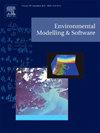Distribution-agnostic landslide hazard modelling via Graph Transformers
IF 4.8
2区 环境科学与生态学
Q1 COMPUTER SCIENCE, INTERDISCIPLINARY APPLICATIONS
引用次数: 0
Abstract
In statistical applications, choosing a suitable data distribution or likelihood that matches the nature of the response variable is required. To spatially predict the planimetric area of a landslide population, the most tested likelihood corresponds to the Log-Gaussian case. This causes a limitation that hinders the ability to accurately model both very small and very large landslides, with the latter potentially leading to a dangerous underestimation of the hazard. Here, we test a distribution-agnostic solution via a Graph Transformer Neural Network (GTNN) and implement a loss function capable of forcing the model to capture both the bulk and the right tail of the landslide area distribution. An additional problem with this type of data-driven hazard assessment is that one often excludes slopes with landslide areas equal to zero from the regression procedure, as this may bias the prediction towards small values. Due to the nature of GTNNs, we present a solution where all the landslide area information is passed to the model, as one would expect for architectures built for image analysis. The results are promising, with the landslide area distribution generated by the Wenchuan earthquake being suitably estimated, including both zeros, the bulk and the extremely large cases. We consider this a step forward in the landslide hazard modelling literature, with implications for what the scientific community could achieve in light of a future space–time and/or risk assessment extension of the current protocol.
通过图形变换器建立与分布无关的滑坡灾害模型
在统计应用中,需要选择与响应变量性质相匹配的合适数据分布或可能性。要从空间上预测滑坡群的平面面积,最常用的似然法是对数高斯分布。这就造成了一种限制,妨碍了对极小和极大滑坡进行精确建模的能力,后者可能会导致危险的低估危害。在此,我们通过图形变换器神经网络(GTNN)测试了一种与分布无关的解决方案,并实施了一个损失函数,该函数能够强制模型捕捉滑坡面积分布的大部分和右尾部。这种以数据为导向的危险评估方法的另一个问题是,人们通常会将滑坡面积等于零的斜坡排除在回归程序之外,因为这可能会使预测值偏小。鉴于 GTNN 的特性,我们提出了一种解决方案,即把所有滑坡面积信息都传递给模型,这也是为图像分析而构建的架构所期望的。结果很有希望,汶川地震产生的滑坡面积分布得到了适当的估计,包括零、大块和超大的情况。我们认为这是在滑坡灾害建模文献方面向前迈出的一步,对科学界未来根据当前协议进行时空和/或风险评估扩展所能取得的成果具有重要意义。
本文章由计算机程序翻译,如有差异,请以英文原文为准。
求助全文
约1分钟内获得全文
求助全文
来源期刊

Environmental Modelling & Software
工程技术-工程:环境
CiteScore
9.30
自引率
8.20%
发文量
241
审稿时长
60 days
期刊介绍:
Environmental Modelling & Software publishes contributions, in the form of research articles, reviews and short communications, on recent advances in environmental modelling and/or software. The aim is to improve our capacity to represent, understand, predict or manage the behaviour of environmental systems at all practical scales, and to communicate those improvements to a wide scientific and professional audience.
 求助内容:
求助内容: 应助结果提醒方式:
应助结果提醒方式:


